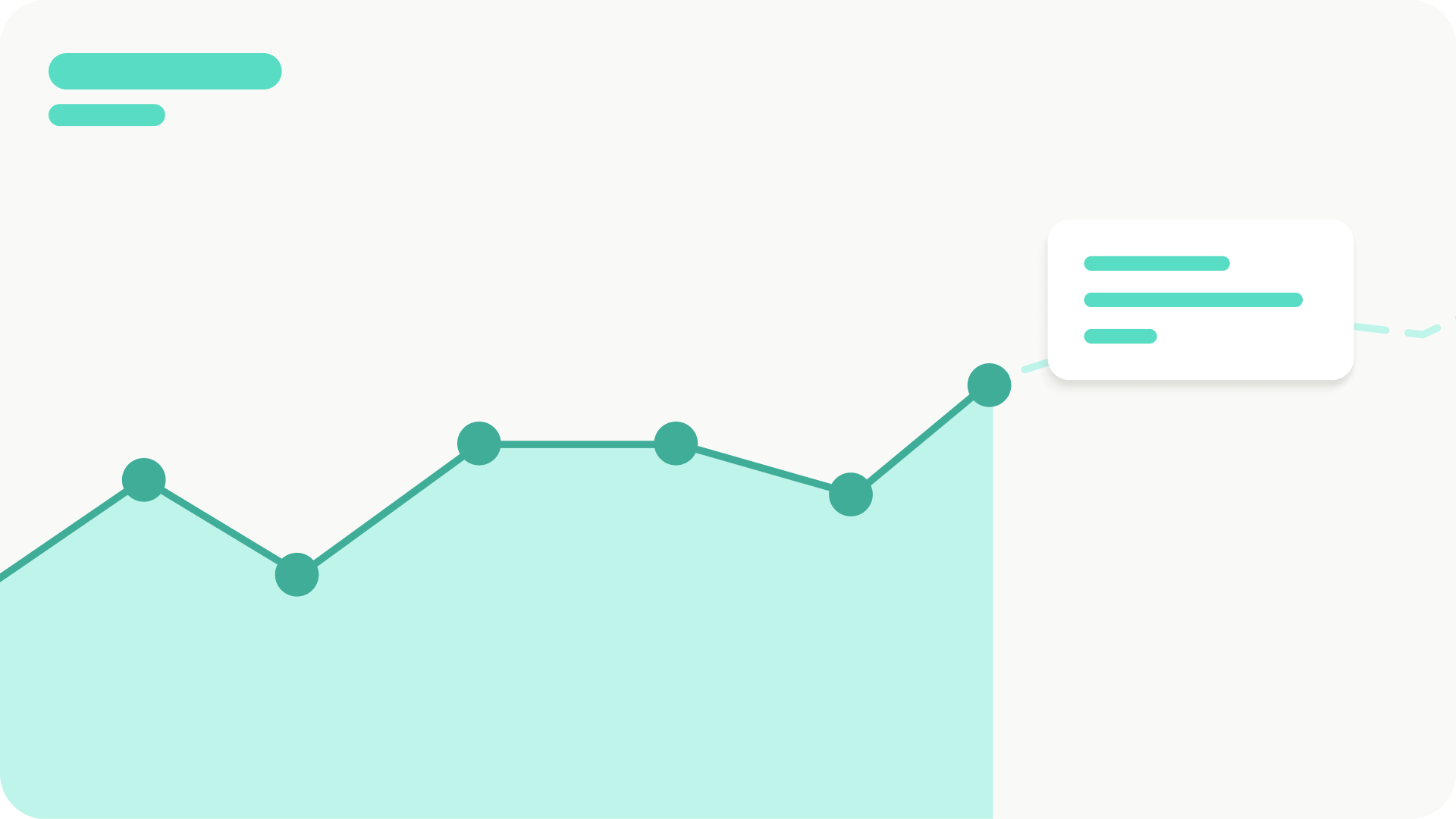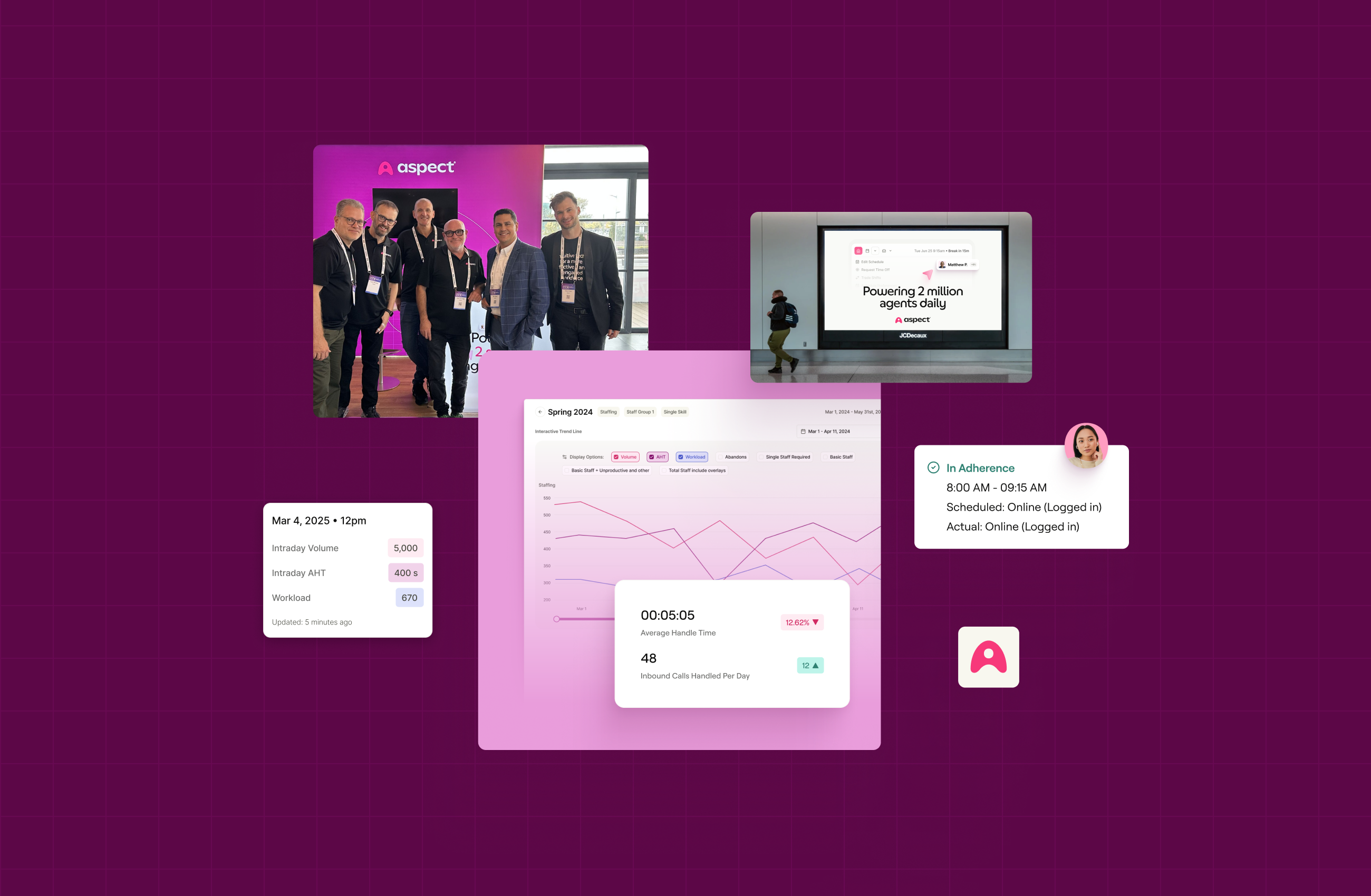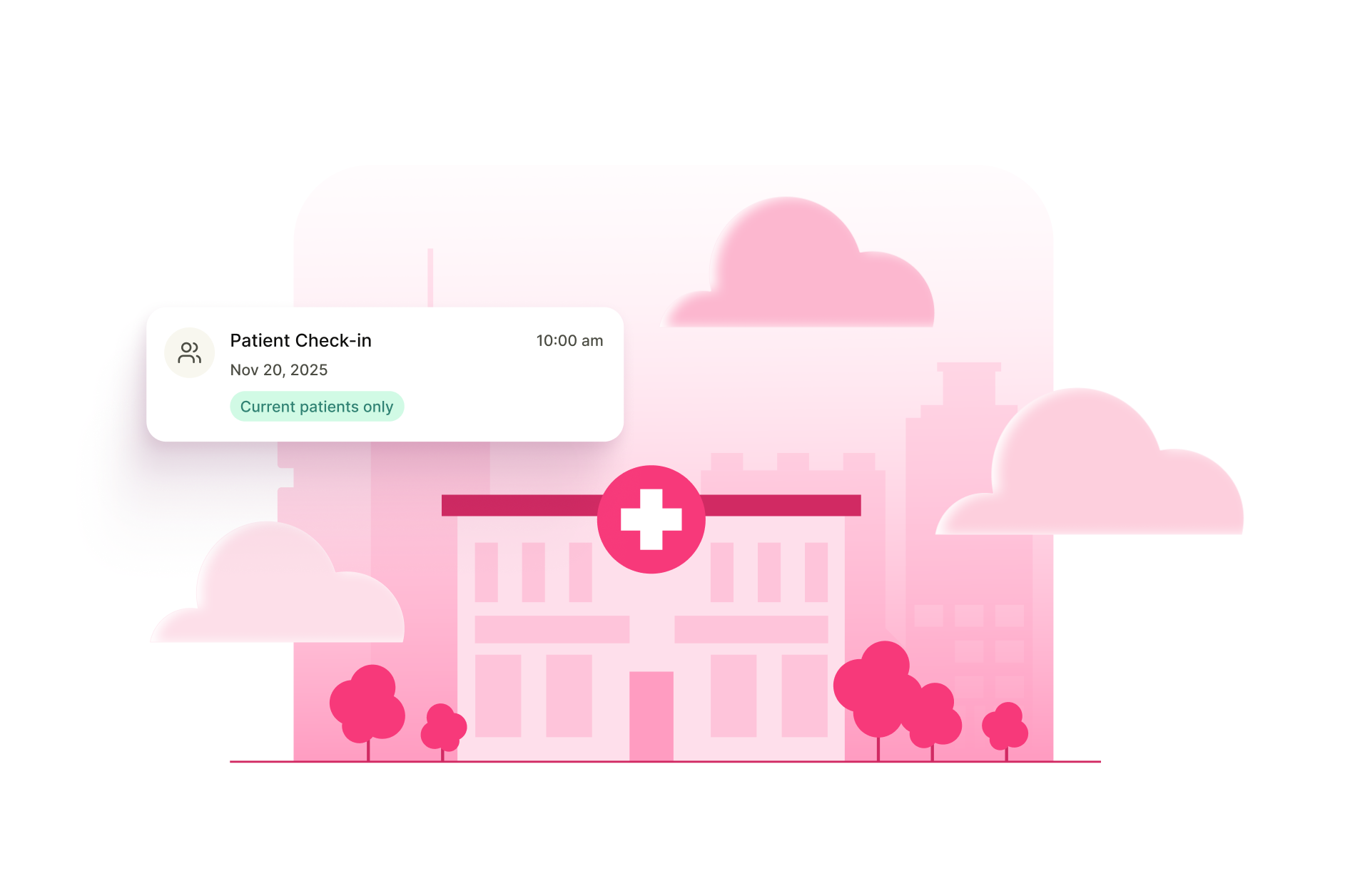When managing a call center, no day is ever predictable. One moment everything's running smoothly, and the next you're dealing with unexpected absences or a sudden surge in customer interactions.
For workforce leaders, hitting service levels is only half the job. The other half is managing the people who make those numbers possible.
This guide covers the fundamentals of call center management, from tracking the most important KPIs to implementing solutions that help leaders manage operations effectively at any scale.
What is call center management?
Call center management is the process of overseeing the day-to-day operations of a call center while solving problems that emerge throughout each day. It covers how agents are scheduled, how customer interactions are handled, and how performance is measured against business goals.
At its core, management is about keeping operations running smoothly while balancing the needs of customers, employees, and the business.
But sometimes, management may feel like they're putting out fires instead of strategic planning. Adherence gaps, absenteeism, and poor forecasting result in missed SLAs, increased operational costs, and agent attrition. It also leads to manager burnout by making it difficult to address staffing needs with any predictability.
Strong call center management uses workforce management tools and data-driven strategies to deliver consistent service. Managers monitor important metrics like first call resolution and schedule adherence, then use those insights to make changes that reduce SLA variance and keep customers satisfied.
Current challenges and opportunities in call centers
Today’s call centers operate in a complex environment where customer needs, employee expectations, and business goals often pull in different directions. They struggle with fragmented systems, ineffective integrations, and compounding inefficiencies that make days feel unpredictable.
- High agent turnover: Call center work can be stressful, with agents handling 40–50 calls daily. Without schedules that fit their lives and clear development paths, many employees leave within their first year. This drives up recruitment costs and creates knowledge gaps.
Metrigy's research shows turnover rose from 21.8% in 2022 to 28.1% in 2023, continuously increasing year after year. Contributing factors include the challenge of finding candidates with the right mix of skills, rapid company growth, and limited budgets—but also unclear career paths and lack of engagement practices.
This makes coaching sessions, recognition programs, and dynamic scheduling vital for keeping agents on staff and building a stable workforce.
- Remote and hybrid workforce: Flexibility benefits employees, but it adds complexity to scheduling, monitoring, and engagement.
Managers need workforce management tools with real-time tracking and communication features to keep distributed teams productive and engaged.
- Rising customer expectations: Customers want fast, personalized service across multiple channels and are less tolerant of delays or repeated transfers.
This challenge creates an opportunity to use data-driven forecasting, automation, and quality monitoring tools that align staffing and skills with customer demand.
- Cost pressures: Organizations must balance operational efficiency with service level requirements while managing overtime spikes, SLA penalties, and rising costs.
WFM tools use accurate forecasting to predict demand patterns and multi-channel interactions, enabling workforce managers to schedule the right number of agents at the right time. This reduces overstaffing, minimizes overtime, and prevents service level misses that lead to SLA penalties.
Key roles in call center management
A call center relies on different roles working together. Each has its own tasks and challenges, but they all contribute to smooth operations and overall success.
Contact center managers
Contact center managers deal with the pressure of hitting targets while managing costs and keeping teams engaged. They monitor KPIs, including service levels, call handling times, and customer satisfaction, while making strategic decisions about staffing, budgets, technology investments, and process improvements.
They must also communicate with senior leadership about performance trends and resource needs.
Supervisors and team leaders
Supervisors and team leaders work directly with agents while handling escalated issues and trying to maintain morale in a high-pressure environment. They review calls, provide coaching, and work to reduce attrition rates.
Their biggest challenge involves keeping agents engaged and productive.
Quality assurance specialists
QA specialists monitor and evaluate customer and agent interactions across calls, emails, and chats to maintain service excellence and regulatory compliance.
They identify performance gaps, coach team members on best practices, and recommend operational improvements that elevate the customer experience while building agent skills and maintaining consistent service quality.
Workforce managers
Workforce managers handle the complex task of scheduling and forecasting while adapting to constant changes and last-minute adjustments.
They analyze call patterns to predict volume fluctuations, align shifts with expected demand, maintain appropriate staffing levels, and minimize labor costs - all while meeting service requirements and avoiding SLA penalties.
Their main challenge is finding the right balance. Understaffing creates long wait times, frustrates customers, and overloads the team. Overstaffing increases operational costs.
Essential metrics to track in call center management

Performance metrics reveal how well a call center operates. They give managers clear insights into efficiency, service quality, and customer outcomes that directly impact business success.
Tracking the right metrics helps you identify what's working and what needs improvement. Focus on the following:
- Average Handle Time (AHT): AHT tracks how long it takes to complete a customer interaction, from the first “hello” to after-call work. Lower AHT can signal efficiency, but rushing agents often creates quality problems and repeat calls. Managers can use call recordings and analytics to see where conversations slow down and guide agents on handling interactions more efficiently.
- First Call Resolution (FCR): Customers don’t want to call back for the same problem. FCR measures how often issues are resolved the first time. Higher FCR points to strong training and clear processes, while lower rates usually mean gaps in agent knowledge, poor tools, or inadequate training. Routing systems and AI-assisted knowledge bases can help agents raise this number.
- Schedule Adherence: This metric shows how closely agents stick to their assigned shifts and breaks. When adherence drops, service levels suffer and overtime costs rise. Real-time adherence monitoring and agent self-service scheduling features make it easier to keep adherence on track while giving agents more control over their schedules.
- Customer Satisfaction (CSAT): CSAT captures how customers feel after an interaction. Tracking it side by side with call data helps managers see if speed and efficiency are actually translating into positive experiences.
- Agent Utilization: This measures how much of an agent’s time is spent handling calls or chats versus being idle. Workforce management software helps spread work evenly, keeping agents productive without overwhelming them.
Best practices and strategies for modern contact center management
Effective management means having clear steps that reduce daily chaos and create predictable operations. Call center leaders need actionable strategies they can implement immediately, build on over months, and sustain long-term.
Start with quick wins
Managers should start by checking analytics dashboards to identify where call volumes are rising and service levels are falling.
Small adjustments—like reassigning agents to busy queues or holding quick coaching huddles—can ease pressure immediately. A simple shout-out to top performers in a team chat can also boost morale and performance instantly.
Build short-term improvements
Over the next month or two, leaders should evaluate their scheduling process. Workforce scheduling software makes it easier to match shifts with demand, reduce unnecessary overtime, and give agents more control over their schedules.
This is also the time to establish regular feedback loops—like pulse surveys or one-on-one check-ins—to gather insights from staff and customers.
Plan for long-term success
Over time, analytics and engagement tools provide the foundation for sustained growth. Managers can use forecasting data to reduce turnover by adjusting training to meet agent needs and aligning staffing with customer demand.
Another long-term strategy is gamification, which encourages healthy competition, reinforces learning, and keeps agents motivated beyond scheduling and pay.
How Aspect supports call center management

Managing an enterprise contact center is a balancing act between efficiency, employee engagement, and customer satisfaction while dealing with daily operational challenges.
Aspect’s workforce management solutions are designed to address these challenges directly, helping leaders put best practices into action with a unified platform that lets people perform at their best.
Here’s how Aspect supports modern call center management:
Workforce scheduling
Aspect’s dynamic scheduling tool makes planning and managing shifts easier for managers and agents by combining automation with flexibility.
- Builds balanced schedules by factoring in call volumes, time-off requests, and capacity limits.
- Allows managers to set rules for overtime control and compliance.
- Factors in time-off requests and employee preferences without disrupting coverage.
- Gives agents tools for shift trading and self-service scheduling.
- Offers a native mobile app for iOS and Android that gives agents and managers complete access to workforce scheduling at their fingertips.
- Sends real-time updates and notifications to keep everyone in sync.
- Automates break planning to reduce manual adjustments during the day.
Workforce forecasting
Aspect’s forecasting software gives managers the precision they need to plan ahead and stay flexible as demand changes.
- Predicts call volumes with advanced algorithms that use historical and external data.
- Runs unlimited what-if scenarios to test strategies before making changes.
- Adjusts staffing in real time through automatic reforecasting and intraday planning.
- Covers all customer channels so forecasts account for calls, chats, and digital touchpoints.
- Allocates demand across multiple sites, remote teams, or hybrid models.
- Supports budget planning by projecting labor needs and reducing overspend.
- Optimizes staffing for peak periods to protect service levels and customer satisfaction.
Productivity tracking
Aspect’s productivity tracking tools give managers the visibility they need to optimize performance and keep teams focused.
- Tracks agent adherence in real-time so managers can make adjustments on the spot.
- Identifies shrinkage from breaks, absenteeism, or non-productive time.
- Measures occupancy rates to understand how effectively time is being used.
- Analyzes performance trends using historical and external data.
- Consolidates multi-channel performance insights into one view for stronger decision-making.
Performance management
Aspect’s performance management software helps leaders boost productivity and keep agents engaged by turning data into actionable insights.
- Tracks KPIs with clear dashboards that show trends and performance gaps.
- Produces reports that combine performance data with other business systems.
- Aligns individual and team goals with company-wide objectives to reduce misdirection.
- Provides real-time feedback and coaching to strengthen communication and support.
- Connects with learning tools to create a cycle of continuous development.
Quality management
Aspect’s quality management software helps managers improve customer interactions, strengthen compliance, and support agent development.
- Evaluates agent performance with scorecards and recording reviews tied to company goals.
- Delivers coaching and feedback immediately when interactions fall short.
- Provides PCI-compliant recording options to safeguard sensitive customer data.
- Consolidates and manages recordings for easy access to historical analytics.
- Retrieves customer interactions quickly with customizable search tools.
- Improves workflows by highlighting gaps and productivity issues in reports.
Read more about the best practices for contact center quality management.
Workforce gamification
Aspect’s gamification platform, Aspect League™, helps managers build engagement, strengthen teamwork, and make performance goals more rewarding.
- Creates customized challenges that encourage employees to build new skills and grow.
- Reduces turnover by making daily work more engaging and rewarding.
- Boosts productivity by linking competitions and rewards to key business goals.
- Supports a culture of recognition with flexible rewards for top performers.
By choosing Aspect's unified AI-powered platform, call center leaders can build more reliable operations that adapt to real-world demands, ultimately driving better results for teams and customers alike.
Want to elevate your call center management? Download our white paper "Driving success in workforce management."
- What are the core responsibilities of a call center manager?
A call center manager oversees daily operations, keeps service level targets on track, and keeps both customers and employees satisfied. The role mainly includes monitoring performance, coaching agents, managing schedules, and reporting on key metrics.
In larger environments, managers also coordinate with workforce management teams and IT to align processes and compliance requirements.
- How can I improve call center performance quickly?
Here are some tips for boosting performance:
- Start with visibility. Track metrics like average handle time, first call resolution, and schedule adherence to see where gaps exist.
- Adjust staffing patterns to better match demand and reduce wait times.
- Provide targeted coaching sessions that focus on specific performance gaps.
- Invest in workforce tools that support real-time monitoring and long-term efficiency.
- Refine training programs to build your agent’s confidence and consistency.
- Foster a culture that values customer outcomes while keeping employees engaged.
- What tools help with call center scheduling and forecasting?
Workforce management (WFM) software is the standard for scheduling and forecasting in call centers. These tools analyze historical data to predict call volumes, then generate staffing plans to match demand.
In enterprise settings, advanced WFM platforms also handle union rules, intraday changes, and multi-site coordination. Solutions like Aspect’s WFM are designed to give leaders accuracy, flexibility, and real-time control over complex operations.









